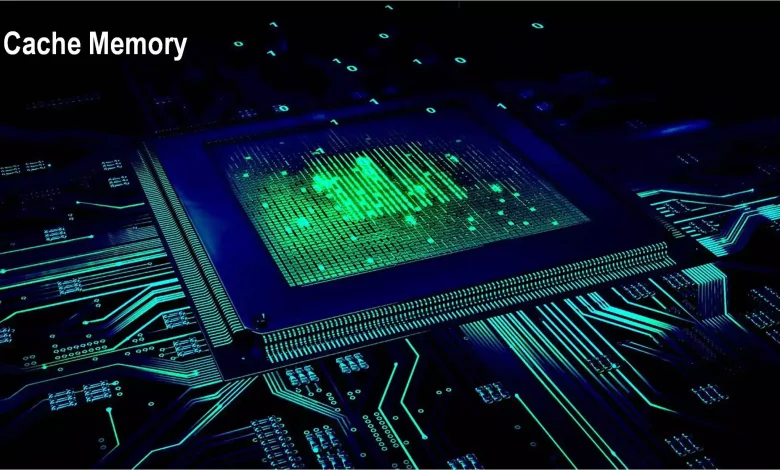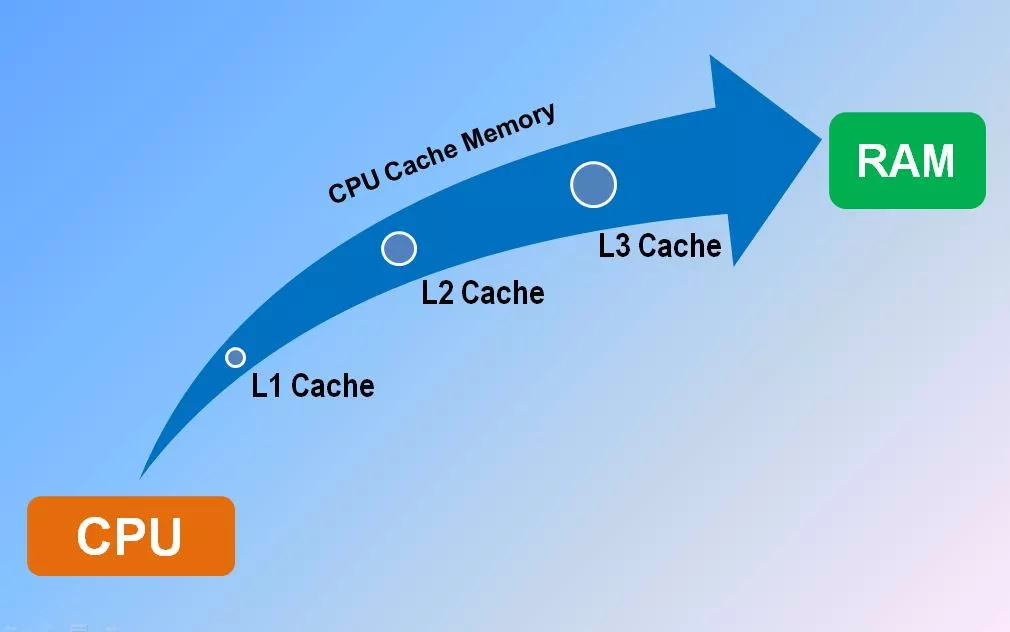CPU Cache Memory and its Types for Fast Computation


CPU Cache Memory is a type of memory that improves the performance of a computer’s central processing unit (CPU). It stores frequently accessed data and instructions to quickly retrieve them when needed. Cache helps to minimize the number of times the CPU needs to access main memory, thereby speeding up overall system performance.
CPU Cache Memory helps improve system performance by reducing the need for a CPU to access main memory each time it needs data or an instruction.
Storing this information closer to the processor can be accessed more quickly, resulting in significantly faster processing times.
Types of CPU Cache Memory
There are three types of CPU Cache Memory:
- Level 1 (L1)
- Level 2 (L2)
- Level 3 (L3)
L1 Cache Memory: Its Size and Purpose
L1 Cache Memory is also known as Level 1 Cache, and it is the fastest type of memory that is located on the processor chip and divided into two caches – an instruction cache and a data cache.
The purpose of this type of Memory is to store frequently accessed instructions and data so that they can be quickly retrieved when required.
The size of the L1 Cache varies depending on the processor type, ranging from 32 KB to 512 KB. It is also typically split between the instruction and data cache, with around half the space allocated for each.
This type of memory also includes a write-back feature that temporarily stores modified data before writing it to the RAM (main memory) and a branch prediction feature that helps the processor predict which instructions should be executed next.
If the size of the L1 Cache memory is large, the processor can access data faster and improve system performance.
L2 Cache Memory: Its Size and Purpose
L2 Cache, also known as Level 2 Cache, is the second fastest type of cache memory after L1 Cache. It is located on the processor chip and is typically larger than L1 Cache Memory.
The purpose of L2 Cache Memory is to store frequently accessed instructions and data that are not stored in L1 Cache to quickly retrieve them when needed. It helps to minimize the number of times the CPU needs to access main memory, thus improving system performance.
The size of L2 Cache Memory varies depending on the processor type and can range from 256 KB to 8 MB. It is also typically divided between the instruction and data cache, with around half of the space allocated for each. L2 Cache also has a write-back feature.
L3 Cache Memory: Its Size and Purpose
L3 Cache, also known as Level 3 Cache Memory, is the third fastest type of cache memory after L1 and L2 Cache. It is located on the processor chip and is typically much larger than L1 and L2 Cache.
The purpose of L3 Cache Memory is to store frequently accessed instructions and data that are not stored in L1 or L2 Cache to quickly retrieve them when needed.
The size of L3 Cache Memory varies depending on the processor type and can range from 1 MB to 32 MB. It is also typically divided between the instruction and data cache, with around half the space allocated for each.
L3 Cache is an important part of any modern computer system as it helps improve system performance by providing quick access to frequently used instructions and data that do not fit in L1 or L2 Cache.
By having high memory L3 Cache, the processor can access more data faster and thus further improve system performance.


Here’s a tabular comparison of L1, L2, and L3 caches:
| Cache Level | Proximity to CPU | Size | Latency | Shared | Purpose |
| L1 Cache | Closest | Small | Very low | No | Store frequently used instructions and data for quick access |
| L2 Cache | Intermediate | Medium | Low | No | Secondary cache for data and instructions not found in L1 cache |
| L3 Cache | Farthest | Large | Medium | Yes | Shared among multiple cores or CPU clusters, reduces need for frequent access to RAM |
What is the Main Purpose of This Memory?
Cache reduces the number of times the CPU needs to access main memory, which further aids in improving system performance. In short, Cache Memory helps provide faster access to data and instructions, reducing response time and improving overall system performance.
Is it possible to Delete CPU Cache Memory?
Yes, it can be possible in that case if the Cache becomes corrupted or you must free up memory resources for other tasks.
To do this, you must access your computer’s BIOS settings and disable the caching option. It’s important to note that disabling the CPU cache may help with some tasks but can also reduce overall system performance. Therefore, it is best to only do this if necessary and for a short period.
You must reset your BIOS settings to their original state before disabling the CPU cache memory to restore the system’s performance.
What are Some Common Uses of Cache Memory?
- It is often used for various activities, including speeding up web browsing, enhancing system responsiveness, and loading programs more quickly.
- Cache Memory may assist with data security by storing passwords and encryption keys in a secure location that only the processor can only access. It can also increase the performance of gaming consoles and media streaming services.
- It also performs several other functions that enhance user experience and system performance.
Factors that Affect Cache Size
Several factors, including the processor type, number of cores, clock speed and available main memory, determine Cache Memory’s size. The type of software used and how frequently it is accessed can also affect Cache Memory size.
System performance goals also play a role in determining the amount of Cache necessary. These factors must be considered when deciding on a suitable amount of Cache for a particular system.
Advantages of having a Larger Cache Memory
Having a larger Cache Memory size has several advantages.
- Firstly, it can help with faster access to frequently used instructions and data, which improves system performance.
- It helps reduce the number of times the CPU needs to access main memory, reducing response time and improving overall system performance.
- Having a larger Cache also allows for greater flexibility with how tasks are executed since larger amounts of data can be stored in the Cache, reducing the number of instructions that need to be fetched from the main memory.
Thus, having a larger Cache Memory is beneficial for improving system performance and increasing user experience.
What Should be Executed Next After Deciding on Cache Memory Size?
Once you have decided on the appropriate Cache size for your system, the next step is to configure the memory controller. This will involve setting up the address and data buses and configuring cache-related features such as write-back and prefetching.
You must also enable specific power-saving features like power management and clock gating. Once all these steps have been completed, the Cache Memory should be ready to use, and you can use its performance benefits.
Wrapping Up
Cache Memory is an important component in modern systems that helps improve overall system performance. It is also possible to customize the size of Cache Memory to maximize performance or increase user experience.
Disabling the CPU cache can be done in certain situations when necessary and for a short period. Therefore, it is important to correctly configure the memory controller once you have decided on a suitable Cache size.
CPU cache is a small and fast memory component integrated into a computer’s central processing unit (CPU). Its purpose is to store frequently accessed data and instructions, providing faster access than the computer’s main memory (RAM).
Cache memory acts as a buffer between the CPU and RAM, reducing the time it takes for the CPU to retrieve data from memory.




